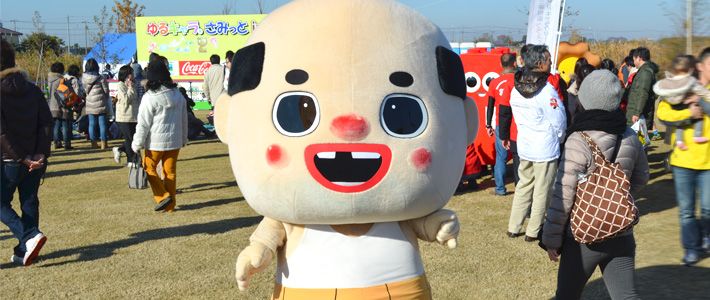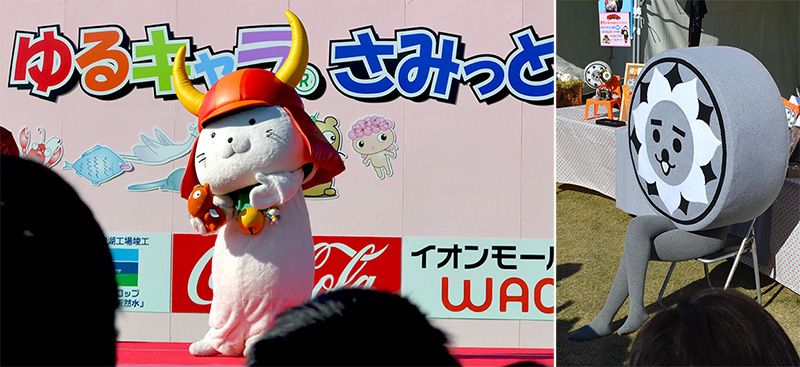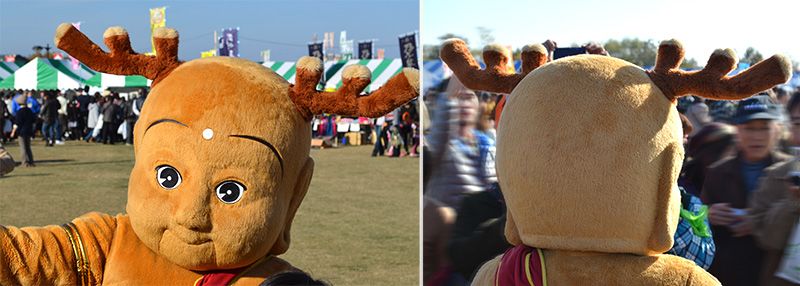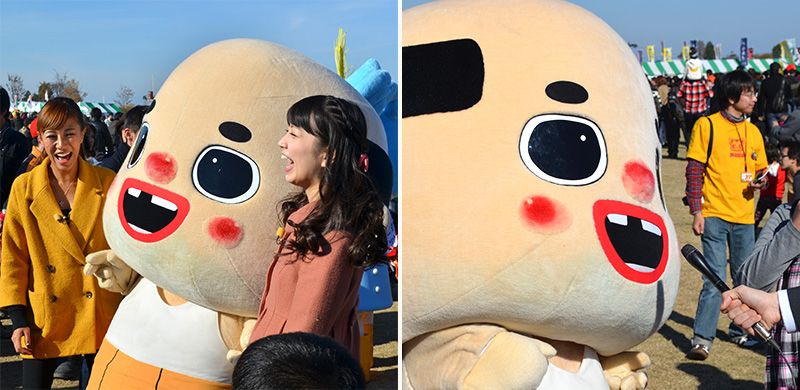
Fluffy Mascots on the Loose in Saitama
Culture- English
- 日本語
- 简体字
- 繁體字
- Français
- Español
- العربية
- Русский
Some countries have an unwritten rule: Cute mascots should not venture beyond the amusement park or sports stadium. But Japan is a land where these fuzzy creatures roam free: where no town is too small, no product too plain, no PR campaign too obscure to miss out on having its own mascot.
These promotional mascots are called yuru kyara, a term coined by the illustrator Miura Jun. It combines the word for “character” with yuru (literally “loose”) to suggest the down-home goofiness of local mascots.
On November 24 and 25, over 250 yuru kyara from across Japan descended on Hanyū, Saitama Prefecture, for the Yuru Kyara Summit. The event drew around 300,000 apparently sane people to this far-flung suburb of Tokyo. I took the train there to find out what all the “fuzz” was about.
Setting foot in a park bustling with a couple hundred clumsy mascots is an unsettling experience to the uninitiated. So many bright colors; so many smiling faces (at least on mascots equipped with mouths); so many characters shaped like animals, fruits, or vegetables (or some diabolical combination of the three)—all of them determined to out-cute one another.
The park was lined with booths flogging the mascots’ merchandise and food from their local areas. There were also two “PR stages” where the mascots waited their turn to be introduced to their fans and shimmy to their theme songs. The rest of the time, the mascots were free to waddle about the park with the help of their assistants, who were also in charge of handing out the mascots’ often elaborate business cards.
After a while, I found myself gravitating toward the stranger mascots. There was such a superabundance of characters that the conventionally cute ones seemed to cancel each other out.
 My first encounter with Chitchai Ossan.
My first encounter with Chitchai Ossan.
Chitchai Ossan from Amagasaki, Hyōgo Prefecture, was one of the first oddballs I ran into. His English name gives you the gist: “Small Middle-Aged Man.” But based on what I saw and the blurb about him in the event pamphlet, a more precise description would be “small, pot-bellied, drunk, and slovenly middle-aged man.” His assistant tells me the mascot was created because Amagasaki is crawling with friendly middle-aged men not so different from Chitchai Ossan. Let the tourist rush commence, I suppose.
 A squatting Melon Kuma about to spring into action as his assistant looks on.
A squatting Melon Kuma about to spring into action as his assistant looks on.
Another character that cut out the cute was Melon Kuma, a ferocious-looking bear with a head the shape and texture of a melon. The mascot hails from Yūbari, Hokkaidō, a city famous for its melons, and fearful of melon-munching bears. The scariness of the character was offset by the mascot’s charming sidekick, an older woman who was also sporting a melon-shaped head.
Goo-Goo the Hambearger was a bit of a head-scratcher. The photo of the mascot in the official pamphlet —a bear with outstretched arms and what looked like tread marks on its chest—screamed “road kill” to me. In fact, the character was created by a group in Shizuoka Prefecture to promote the consumption of hamburgers—those are grill marks on the bear’s chest, apparently.
Looking like a cross between a fox and a smoked pig was Peccary from the Bizen Museum of Central and South American Art in Okayama Prefecture, accompanied by the museum’s curator, dressed in historical costume. This unique mascot was hands-down the creepiest thing on two legs in Hanyū that day.
Other mascots caught my eye through a “simple-is-best” approach. Perhaps the simplest was Konnyakun, the mascot of a Japanese trade association that promotes konnyaku—a nearly tasteless jelly-like food. For a wholesome, ho-hum product like konnyaku, the choice of a gray mascot shaped like a sofa cushion seemed the perfect fit.
 (clockwise from top) Saipon trio, Peccary, Konnyakun, Goo-Goo the Hambearger.
(clockwise from top) Saipon trio, Peccary, Konnyakun, Goo-Goo the Hambearger.
Anyone secretly hoping that the authorities might one day cull Japan’s mascot population would have been disheartened to see Saipon, a trio of mascots representing the Saitama Prefecture–based Air, Ground, and Maritime Self-Defense Forces. I managed to locate their camouflaged booth and take a few photos of the three. Their profile blurb informed me that, although gentle by nature, they have the power to fell a lion in single blow if angered. I exercised due caution.
Spotting the celebrities in the mascot world was easy enough: just look for the crowd of adoring fans. When the character Hikonyan from Shiga Prefecture graced the PR stage it was a mob scene. This mascot, created to mark Hikone Castle’s 400th anniversary, is one of the first yuru kyara superstars.
 The mascot legend Hikonyan on stage and Nishiko-kun taking a breather.
The mascot legend Hikonyan on stage and Nishiko-kun taking a breather.
Then there is the quirky up-and-comer, Nishiko-kun, from the Tokyo suburb Nishi-Kokubunji; a mascot famous for showing off a shapely pair of (human) legs clad in gray leotards.
And everyone knows the boy-Buddha with a pair of antlers poking out of his head, Sento-kun—a mascot unveiled by Japan’s ancient capital, Nara, to mark the city’s 1,300th anniversary in 2008. Initially ridiculed as kawaikunai (plain), the worst insult imaginable in cute-crazy Japan, the character has gone on to win a place in many people’s hearts despite (or because) of its questionable cuteness. To be honest, I’d been creeped out by the images I’d seen of Sento-kun, and was ready to make fun of him. But when I finally stumbled across the mascot at the event, he instantly won me over with his big round eyes and “aw shucks, I got antlers on my head” expression.
 Who can resist the peculiar charm of Sento-kun?
Who can resist the peculiar charm of Sento-kun?
 Make way for a superstar—Barysan on the march.
Make way for a superstar—Barysan on the march.
But the biggest star at this year’s summit, voted most popular character, was Barysan from Imabari, Ehime Prefecture; an over-sized chick with a tiny, bridge-shaped crown perched atop its head. My sole encounter with this new icon was when it was moving, at impressive speed, toward the stage. Swept up by the herd of fans and reporters giving chase, I just managed to snap a few photos.
After that brush with celebrity, it was refreshing to bump into Yamadaruma, representing . . . well, Yamada Ruma, the woman inside the costume. As far as I could tell, she was the only yuru kyara fan to come to the event dressed as a mascot—in a red costume shaped like a Daruma doll.
Over the course of the day I kept running into Chitchai Ossan, and each time the crowd around him was bigger. The last time I bumped into him he was being interviewed by two beautiful young women. Unlike other mascots he can (unfortunately) talk, and the women were pretending to hang on his every word. The media attention clearly had gone to his already enormous head. The middle-aged men back in Amagasaki probably don’t fare so well.
After the event, on the long train ride home, I had a close encounter with another small middle-aged man, who seemed to share Chitchai Ossan’s love of the bottle—but I think I prefer the yuru kyara version.
 Chitchai Ossan was a hit with reporters.
Chitchai Ossan was a hit with reporters.
(Photographs by Michael Schauerte.)
anime manga Doraemon yuru kyara character mascot Miura Jun Saitama Prefecture Hanyu yuru kyara summit













